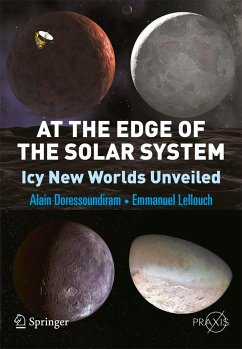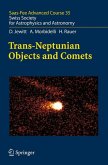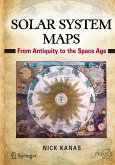On August 24, 2006, the solar system lost its ninth planet! The astronomers' decision at the IAU General Assembly in Prague to demote Pluto had been precipitated by the discovery, beyond the orbit of Neptune, of a very rich population of Pluto-like objects. The study of the recently discovered remote celestial bodies grows ever more fascinating. Their great variety in color, shape, size, and orbit has astonished observers. What is more, studies of the composition of these new-found objects reveals that they among the most primitive objects in the solar system. In their simple and lively style, the authors of At the Edge of the Solar System alternate discussions on historical aspects and physical descriptions of the remote regions, as well as amazing findings from the cutting edge of research.
Beginning with a description of the structure of the solar system, the authors look at the discoveries of Pluto and its moon Charon and show how our knowledge of this mysterious world grew over the last 80 years of its study. They then describe the origins of our solar system and look at the discoveries of the first unusual objects in the outer solar system - Chiron and the first Centaurs. They trace the discoveries of the first Kuiper Belt objects and introduce the wide range of bodies found in the outer solar system, including "Plutinos." Examining these objects in more detail, they then present the arguments concerning the status of Pluto and conclude with discussion of the essential characteristics of the Kuiper Belt and a look at how future observations may lead to yet more discoveries and a greater understanding of these bodies.
Beginning with a description of the structure of the solar system, the authors look at the discoveries of Pluto and its moon Charon and show how our knowledge of this mysterious world grew over the last 80 years of its study. They then describe the origins of our solar system and look at the discoveries of the first unusual objects in the outer solar system - Chiron and the first Centaurs. They trace the discoveries of the first Kuiper Belt objects and introduce the wide range of bodies found in the outer solar system, including "Plutinos." Examining these objects in more detail, they then present the arguments concerning the status of Pluto and conclude with discussion of the essential characteristics of the Kuiper Belt and a look at how future observations may lead to yet more discoveries and a greater understanding of these bodies.
From the reviews:
"Every aspect is covered, discoveries, orbits, origin and physical characteristics. ... In every way this is an outstanding work. It is crammed with information ... the translation into English is so good that it is very readable, the illustrations are excellent, and the glossary is adequate. The book will appeal to both beginners and to serious students ... . Doressoundiram and Lellouch must be heartily congratulated." (Patrick Moore, Sky at Night Magazine, June, 2010)
"Evidently intended for a popular readership, this is an English translation of Aux confins du systeme solaire, written by two Parisian astronomers in 2008. ... Neptune are the most detailed and informative in the book and represent a useful introduction to what modern photometry and spectroscopy ... and, coupled with knowledge of orbital statistics and ideas on the long-term changes in the orbits of the giant planets, how the present conditions have evolved from those just after the Solar System began to form." (Brian G. Marsden, The Observatory, Vol. 130, October, 2010)
"This book reveals Pluto to be a fascinating and important member of a diverse collection of icy bodies. ... All this information is presented in a very readable style and accompanied by around 150 images and diagrams. I fully recommend this book to anyone with an interest in the outer Solar System and how the objects in this region, and others like them, have shaped ours and other planetary systems." (David Powell, Astronomy Now, November, 2010)
"Doressoundiram and Lellouch (both, Observatoire de Paris, France) use 109 stunning illustrations, mostly in color, to develop the subject from the history of the solar system to 1930, through the discovery of Pluto ... and other trans-Neptunian objects like Pluto. ... Includes a 12-page appendix giving the details of 12 major trans-Neptunian objects, a 1-pagebibliography, a 3-page glossary, and a 7-page index. Summing Up: Highly recommended. All readers interested in our solar system." (W. E. Howard III, Choice, Vol. 47 (11), July, 2010)
"Every aspect is covered, discoveries, orbits, origin and physical characteristics. ... In every way this is an outstanding work. It is crammed with information ... the translation into English is so good that it is very readable, the illustrations are excellent, and the glossary is adequate. The book will appeal to both beginners and to serious students ... . Doressoundiram and Lellouch must be heartily congratulated." (Patrick Moore, Sky at Night Magazine, June, 2010)
"Evidently intended for a popular readership, this is an English translation of Aux confins du systeme solaire, written by two Parisian astronomers in 2008. ... Neptune are the most detailed and informative in the book and represent a useful introduction to what modern photometry and spectroscopy ... and, coupled with knowledge of orbital statistics and ideas on the long-term changes in the orbits of the giant planets, how the present conditions have evolved from those just after the Solar System began to form." (Brian G. Marsden, The Observatory, Vol. 130, October, 2010)
"This book reveals Pluto to be a fascinating and important member of a diverse collection of icy bodies. ... All this information is presented in a very readable style and accompanied by around 150 images and diagrams. I fully recommend this book to anyone with an interest in the outer Solar System and how the objects in this region, and others like them, have shaped ours and other planetary systems." (David Powell, Astronomy Now, November, 2010)
"Doressoundiram and Lellouch (both, Observatoire de Paris, France) use 109 stunning illustrations, mostly in color, to develop the subject from the history of the solar system to 1930, through the discovery of Pluto ... and other trans-Neptunian objects like Pluto. ... Includes a 12-page appendix giving the details of 12 major trans-Neptunian objects, a 1-pagebibliography, a 3-page glossary, and a 7-page index. Summing Up: Highly recommended. All readers interested in our solar system." (W. E. Howard III, Choice, Vol. 47 (11), July, 2010)








